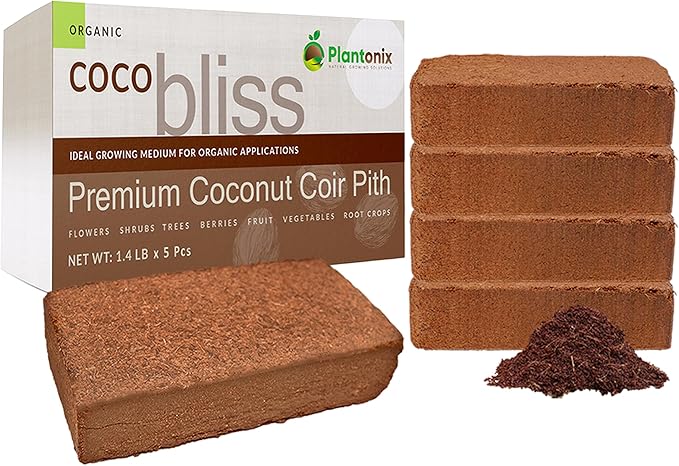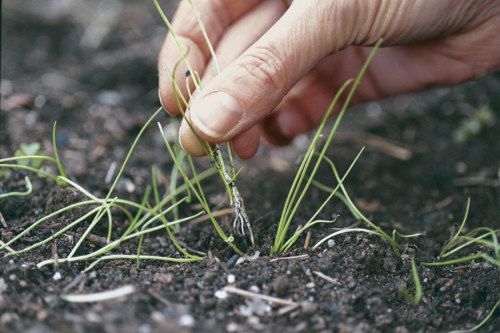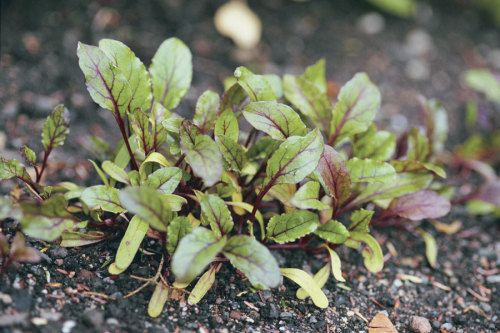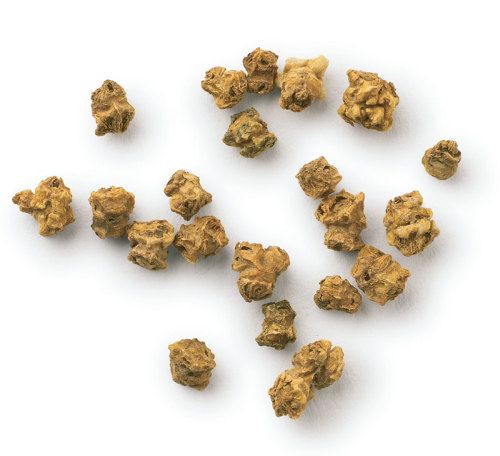
by Cass Peterson
April 1999
from issue #20
Some people hate to see a plant go to waste, as I discovered one day while thinning the chard in the company of an 8-year-old friend. Intent on my task, I didn’t notice until later that every plant I had pulled and tossed aside had been picked up, carried to the far side of the garden and carefully replanted.
What seemed hard-hearted to my gardening companion was necessary. Most vegetables sown directly in the soil, rather than transplanted, will need thinning. Beets and chard, which grow from compound seeds that produce several plants, are especially prone to overcrowding.
In the case of beets, if you don’t thin, you will get all tops and no roots. They must have room to expand underground. With chard, you will get many small, spindly leaves and no large ones with those delectable crunchy ribs. Chard that hasn’t been thinned also has a tendency to bolt.
 |
 |
|
| With some plants, such as chard and beets, the seeds come in clusters that resemble a ball of tiny oysters (left). Even if you plant just one compound beet seed, thinning will be required (right), or there won’t be enough space for roots to form. | ||
It’s far better to have one-tenth of the crop flourishing than the whole lot malnourished and spindly. Some gardeners go to extremes in seeding, taking care to place the tiniest seeds just so in the ground to avoid thinning later. But thinning needn’t be a backbreaking task. Many crops, such as radishes, carrots, and beets, can be thinned while standing and using a garden rake.
When the plants are an inch tall, drag the garden rake lightly through the row or bed on the diagonal, first one direction, then the other. The rake’s teeth will uproot just enough of the plants, leaving the rest nicely spaced.
Harvest and thin in one stroke
The rake technique works well on lettuce, spinach, arugula, and other salad greens, too, but I like to thin those by hand when the leaves are large enough to use in the kitchen. Several light thinnings, rather than one heavy one, will provide salad ingredients for several weeks.
The tender young leaves of greens are so good I often seed salad crops more heavily than necessary to ensure plenty of thinnings. Some root crops also can be thinned by harvesting. Tiny radishes, barely a half-inch in diameter, can be used whole in salads. Baby turnips the size of a dime steam up in just a few minutes, and the leaves can be left on.
If you want baby turnips, however, be sure to grow a variety intended for that purpose, such as ‘Hakurei’ from Johnny’s Selected Seeds. Standard turnips, such as ‘American Purple Top’, don’t size up until the plants are quite large. They will need to be thinned early, before the roots have formed. The young greens can still be eaten.
 |
|
| When leeks flower and then drop their seed in the garden, the young plants naturally tend to congregate in clumps. But to get the best crop, thin the stand so plants have room to develop. | |
No matter how delicious those young greens may be, you need to know when the crop has been sufficiently thinned. Think about the mature size of the plant or root. If you want a 2-inch beet, leave that much space between seedlings. If you want a lettuce with a wing span of 12 inches, give it 6 inches on each side. Carrots, which are delicious even if skinny, can be left at 1⁄2 to 1 inch. But a few will wind around each other at that spacing, which is amusing and still tasty. All bets are off with rutabagas. Given enough spread space and fertility, they will get really,
really big. Joy to the rutabaga lover.
Methods vary with the plant
Not all crops should be thinned by yanking excess plants out of the ground, even with a rake. Peas, beans, and all members of the cucurbit family—cucumbers, melon, and squash—have fragile roots. Pulling up one plant is likely to damage the neighbor on both sides, because their roots will be intertwined.
If it appears that the peas and beans will be overcrowded, thin them immediately after they germinate, before the roots have spread too far. If you procrastinate until they are a couple of inches tall, thin with a pair of scissors, snipping excess plants off at soil level, rather than pulling them roots and all.
The same advice goes for weeding. If the pigweed got ahead of you, cut it off. Pulling large weeds from the pea or bean patch might do the plants more harm than good.
Root and salad crops are not so sensitive to root disturbance. But it is a good idea to thin when the soil is damp rather than dry. Plants will slip out more easily then, and the ones you leave behind will stand less risk of having their roots exposed to air pockets in the soil. If it’s dry when you thin, irrigate the garden as soon as you’re done to resettle the soil around the roots of the survivors.
 |
|
| Thin carrots, but know that the fresh perfume of the disturbed plants will draw carrot flies. Make sure you clear away the thinnings from the garden. | |
A special note about carrots: It’s true that the carrot fly is attracted to the scent of carrots, and thinning will release carroty perfume throughout the garden. The carrot fly, also called the carrot rust fly, lays eggs near the crown of the plant; these hatch into maggots, which tunnel through the roots. I’m always careful to take the thinnings out of the garden, rather than throw them on the ground. I also cover the carrot patch with a polyester row cover, such as Reemay, for several days after thinning to thwart the fly until the scent dissipates.
You can, of course, grant clemency to many of the plants you thin by replanting them elsewhere. Beets are among the few root vegetables that will tolerate transplanting, and chard takes to it very nicely. But be realistic. Thanks to my young friend, I had more chard than I knew what to do with that year.
Fine Gardening Recommended Products

Coco Bliss 650gm Bricks (5-Pack) - Organic Coco Coir
Fine Gardening receives a commission for items purchased through links on this site, including Amazon Associates and other affiliate advertising programs.

Corona E-Grip Trowel
Fine Gardening receives a commission for items purchased through links on this site, including Amazon Associates and other affiliate advertising programs.

Berry & Bird Rabbiting Spade, Trenching Shovel
Fine Gardening receives a commission for items purchased through links on this site, including Amazon Associates and other affiliate advertising programs.





















Comments
Log in or create an account to post a comment.
Sign up Log in